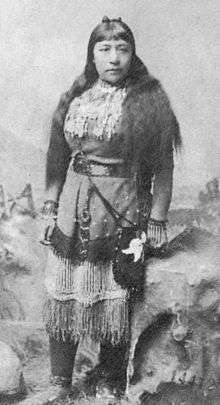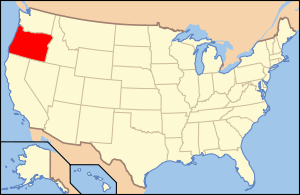Fort Rock Cave
|
Fort Rock Cave | |
|
University of Oregon archaeological excavations at Fort Rock Cave, 1966 | |
| Location | Address restricted[1] |
|---|---|
| Nearest city | Fort Rock, Oregon |
| NRHP Reference # | 66000641 |
| Significant dates | |
| Added to NRHP | October 15, 1966 |
| Designated NHL | January 20, 1961 |
Fort Rock Cave was the site of the earliest evidence of human habitation in the US state of Oregon before the excavation of Paisley Caves. Fort Rock Cave featured numerous well-preserved sagebrush sandals, ranging from 9,000 to 13,000 years old.[2] The cave is located approximately 1.5 miles (2.4 km) west of Fort Rock near Fort Rock State Natural Area in Lake County.[3] Fort Rock Cave was declared a National Historic Landmark in 1961,[4] and added to the National Register of Historic Places in 1966.[5]
The cave was found on Reub Long's ranch. It was formerly known as Menkenmaier Cave and Cow Cave.[6][7]
Archaeology

University of Oregon archaeologist Luther Cressman's 1938 excavations at Fort Rock Cave placed human habitation in Oregon as early as 13,200 years ago.[2][8][9] Cressman's team also recovered numerous examples of sandals woven from sagebrush bark below a layer of Mazama Ash (deposited by the explosion forming Crater Lake about 7600 years ago). Radiocarbon dating of these sandals, now displayed at the University of Oregon Museum of Natural and Cultural History in Eugene and in the town of Fort Rock, has shown some to be over 10,000 years old. This sandal style is known as Fort Rock style, since they were first discovered there. This sandal style is distinct from other variants; they are flat, closed toed and have a twined sole.[10] They have been found at other sites, such as Cougar Mountain and Catlow Caves, as well.[9][11] Several other prehistoric artifacts have been found at Fort Rock Cave, including basketry and stone tools.[12] The artifacts found by Stephen Bedwell in 1970 were found in one of the remaining unvandalized areas of the cave.[12]
See also
- Kennewick Man, skeletal remains discovered in the Pasco Basin
- Marmes Rockshelter, on the lower Snake River
- Paisley Caves, also in eastern Oregon, the site of perhaps the oldest human remains in the Americas
References
- ↑ Federal and state laws and practices restrict general public access to information regarding the specific location of sensitive archaeological sites in many instances. The main reasons for such restrictions include the potential for looting, vandalism, or trampling. See: Knoerl, John; Miller, Diane; Shrimpton, Rebecca H. (1990), Guidelines for Restricting Information about Historic and Prehistoric Resources, National Register Bulletin (29), National Park Service, U.S. Department of the Interior, OCLC 20706997.
- 1 2 Robbins, William G. (2005). Oregon: This Storied Land. Oregon Historical Society Press. ISBN 0-87595-286-0.
- ↑ "Fort Rock Cave, Oregon". Archeological Society of Central Oregon. Retrieved 2008-04-29.
- ↑ "Fort Rock Cave". National Historic Landmark summary listing. National Park Service. Retrieved 2007-11-19.
- ↑ Oregon Parks and Recreation Department, Oregon Historic Sites Database, retrieved June 20, 2014.
- ↑ Brogan, Phil (June 16, 1975). "Geographic board okays naming cave after Long". The Bulletin. p. 2. Retrieved December 8, 2011.
Board directors said the proposal is not a name change – the cavern, oldest known habitation of man in the region, has been known over the years by various names, Menkenmaier Cave, Fort Rock Cave and Cow Cave. It has been known in recent years as Fort Rock Cave, and this has resulted in much confusion with the Fort Rock formation, about a mile and a half to the east. ... Several years ago, Mr. and Mrs. Long formally presented the cave, on Reub Long's land, to the U.S. Park Service. The cave got its Cow Cavern name because Long's cattle sought shelter there from winter storms. ... The Fort Rock basin cave won national attention in 1938 when Dr. L. S. Cressman, University of Oregon anthropologist, found in the old cave a cache of sandals made from sagebrush.
- ↑ "Fort Rock: It's too small for a beer license". The Bulletin. September 1, 1970. p. 7. Retrieved December 8, 2011.
About two miles northwest of the rock is Fort Rock Cave, where the discovery in 1938 of prehistoric sandals established the Fort Rock basin as the oldest known habitat of man in the Oregon country. Anthropologists set the radio-carbon age of the sandals at around 9,000 years. The cave is located on what was once Reub Long's "home" ranch.
- ↑ "Fort Rock State Natural Area". Oregon State Parks. Retrieved 2007-04-09.
- 1 2 "World's Oldest Shoes". University of Oregon. Retrieved 2007-04-09.
- ↑ "Fort Rock Sandals". Retrieved October 17, 2011.
- ↑ Tucker, Kathy (2002). "Fort Rock Sandals". Oregon Historical Society. Retrieved 2007-04-09.
- 1 2 "Cultural Sequence in the Northern Great Basin: The View From Fort Rock". University of Oregon Department of Anthropology. Archived from the original on July 15, 2004. Retrieved 2011-08-16.
External links
| Wikimedia Commons has media related to Fort Rock Cave. |
%2C_1966.jpg)




